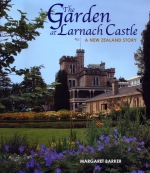 BOOK
REVIEWS BOOK
REVIEWS
The
Garden at Larnach Castle:
A New Zealand story
By Margaret Barker
Published by David Bateman, Auckland
Hardback, 159 pages, 245 x 275mm, New Zealand, 2006
ISBN-13: 978-1-86953-639-8
ISBN-10: 1-86953-639-8.
NZ$49.99
Reviewed by Murray Dawson
Larnach Castle is truly
unique. Located on the Otago Peninsula near Dunedin, it is New Zealand's
only castle.
The Garden at Larnach
Castle: A New Zealand story is written by the castle owner,
Margaret Barker, and recounts her families' personal journey of
some 40 years transforming the castle and grounds from a near ruin
into the award winning tourist attraction of today. The garden is
of National Significance, as first assessed by the RNZIH New Zealand
Gardens Trust in 2004.
Many famous buildings
of the world are also renowned for their associated gardens - UK
has Hampton Court Palace in London and Sissinghurst in Kent, France
has Versailles and Monet's former home Giverny, and Italy has Villa
Aldobrandini and Villa d'Este, to name but a few. Equally, the gardens
at Larnach Castle are an essential living companion and also steeped
in history.
The Prologue of the
book sets the scene with the Barker's first sight of the Castle
in 1967: "The tangle of overgrowth opened out and suddenly it was
before us, Larnach Castle, dreaming in the summer sun of lost days
of grandeur", and the Barker's decision to buy it was made there
and then.
The first chapter provides
a brief biography of William Larnach's life, explaining that he
became wealthy on the back of Otago's goldrush, started work building
the castle in the 1870s, and later became bankrupt and took his
own life in Parliament buildings in 1898. The Castle was stripped
of assets, taken over by the state and used as a mental hospital
for several years, before passing through several owners, most notably
the Purdies.
The early years of the
Barkers' guardianship is told in Chapter 2, which recounts the great
challenges faced getting the Castle buildings functional while raising
a young family and looking after elderly parents at the same time.
The first paragraph sums it up: "The Castle roof was shot, essential
services were unreliable, floors unstable . It was bitterly cold
and damp . and we had a baby on the way".
The remaining 10 chapters
trace the development of particular garden areas in the Larnach
Castle estate.
Aside from large-scale
weed management and clearance of out-of-control trees and shrubs,
the first major project was restoration of Mr and Mrs Purdie's original
rock garden (Chapter 3) that was completely lost in overgrowth.
Development of the "Serpentine
Walk" is described in Chapter 4, so called because it is a curvy
path designed to slow people down so that they can enjoy the adjacent
perennial border. The plants in this border have been carefully
chosen to provide colour and interest throughout the year.
Chapter 5 covers the
patterned garden established to link the former ballroom, now a
café, to the outside eating area. To create this outdoor flow, a
window had to be replaced by a new door constructed by craftsmen
using castings and materials copied from an original door elsewhere
in the Castle.
And so the stories flow
over the subsequent chapters. This book is well illustrated with
some 150 carefully chosen photographs, mostly in colour, but also
including historic black and white photos of the Castle and grounds.
A recurrent theme that
comes through in this book is that gardens are living works and
never truly finished. The Larnach Castle gardens have been influenced
in different ways and at different times by Margaret Barker's travels
to other great gardens of the world and to 'nature's gardens' -
intrepid adventures in the wilds of South America, China, Tasmania,
Lord Howe Island, the Chatham Islands, and the subantarctic islands
of New Zealand.
Many of the plants used
and fashions followed in other great gardens, such as extensive
rose beds, were found to be unsuited to the soil and climatic conditions
of the Otago Peninsula. This is where Margaret Barker instead took
her inspiration from nature, planting more New Zealand native plants
and cool-temperate Pacific plants. This also provides a uniquely
New Zealand context to the gardens. In the so-named South Seas garden
(Chapter 10), much of the extensive Rhododendron collection
was replaced with nikau palms and other coastal and island plants.
Margaret Barker is always
willing to replant, redevelop, and refine her ideas, and these are
the sure signs of an expert plantswoman. And what an achievement
to have the Poor Knights lily Xeronema callistemon from the
far north thriving in the same grounds as the subantarctic megaherb
Stilbocarpa polaris!
This is more than just
a garden book; it documents an important part of the Castle's history
and garden legacy. This record will, thanks to the author and current
owner, endure for future generations.
|